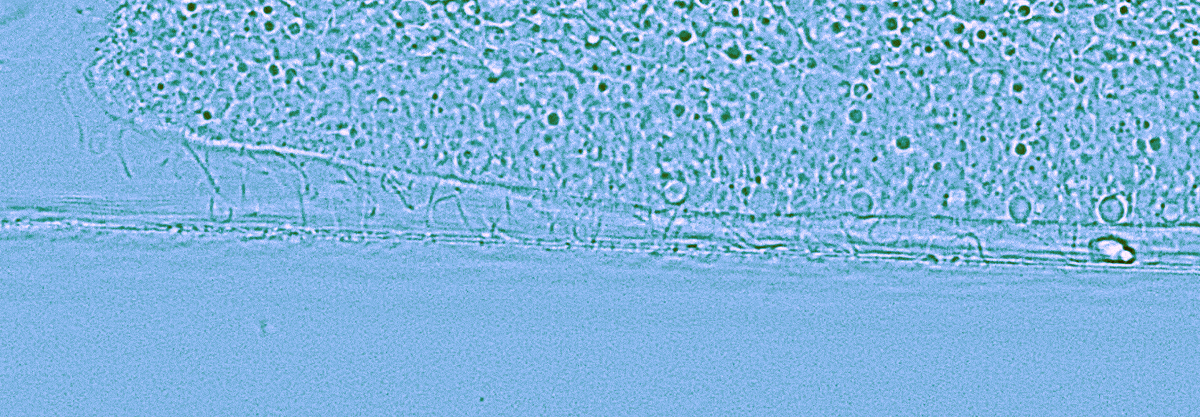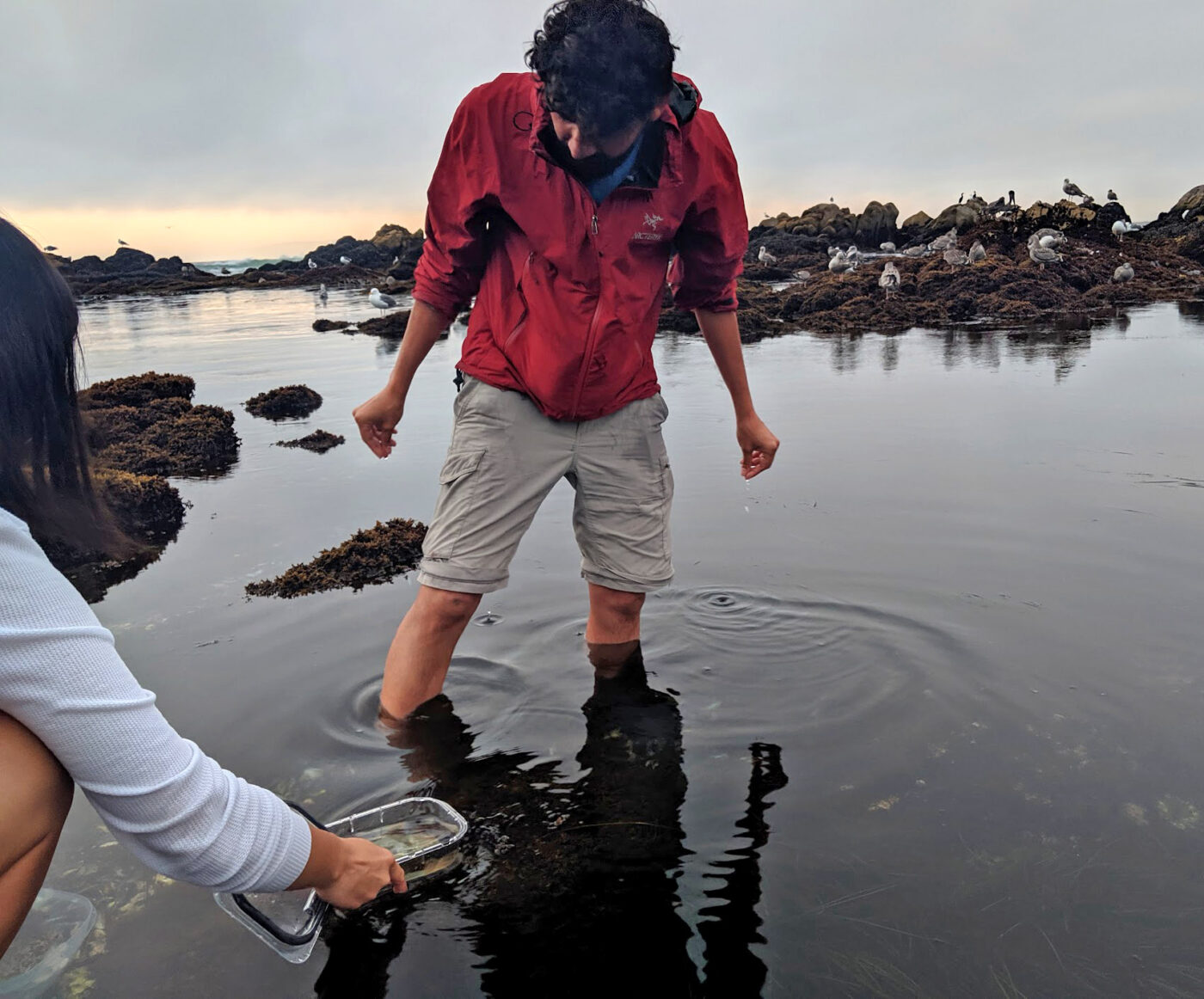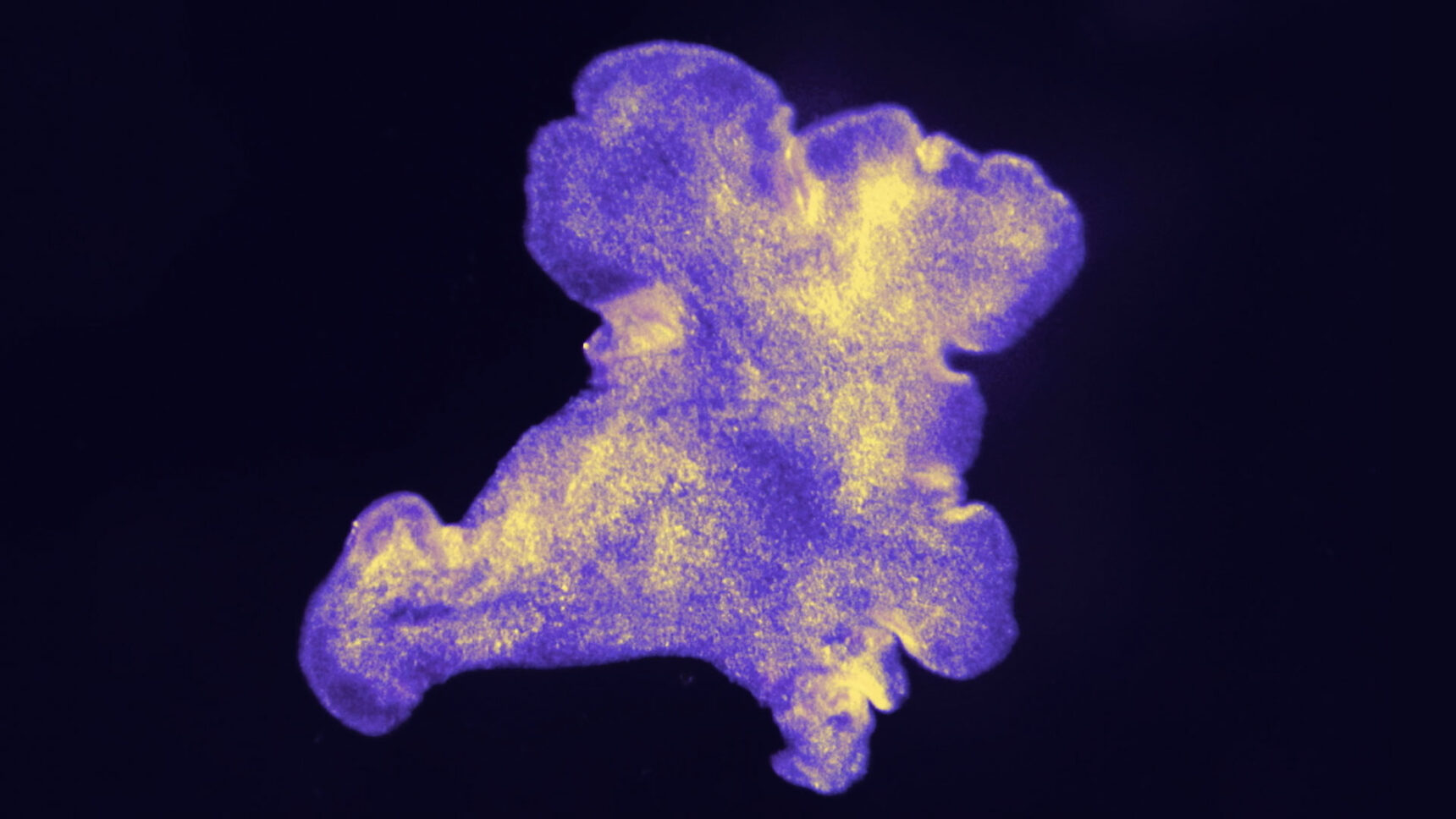This Animal’s Behavior Is Mechanically Programmed
Introduction
The biophysicist Manu Prakash vividly remembers the moment, late one night in a colleague’s laboratory a dozen years ago, when he peered into a microscope and met his new obsession. The animal beneath the lenses wasn’t much to look at, resembling an amoeba more than anything else: a flattened multicellular blob, only 20 microns thick and a few millimeters across, with neither head nor tail. It moved on thousands of cilia that blanketed its underside to form the “sticky hairy plate” that inspired its Latin name, Trichoplax adhaerens.
This odd marine creature, classified as a placozoan, has practically an entire branch on the evolutionary tree of life to itself, as well as the smallest known genome in the animal kingdom. But what intrigued Prakash most was the well-orchestrated grace, agility and efficiency with which the thousands to millions of cells in Trichoplax moved.
After all, such coordination usually requires neurons and muscles — and Trichoplax has neither.
Prakash later teamed up with Matthew Storm Bull, then his graduate student at Stanford University, to make this strange organism the star of an ambitious project aimed at understanding how neuromuscular systems might have evolved — and how early multicellular creatures managed to move, find food and reproduce before neurons existed.
“I often jokingly call this neuroscience without neurons,” Prakash said.
In a trio of preprints totaling more than 100 pages — posted simultaneously on the arxiv.org server last year — he and Bull showed that the behavior of Trichoplax could be described entirely in the language of physics and dynamical systems. Mechanical interactions that began at the level of a single cilium, and then multiplied over millions of cells and extended to higher levels of structure, fully explained the coordinated locomotion of the entire animal. The organism doesn’t “choose” what to do. Instead, the horde of individual cilia simply moves — and the animal as a whole performs as though it is being directed by a nervous system. The researchers even showed that the cilia’s dynamics exhibit properties that are commonly seen as distinctive hallmarks of neurons.
The work not only demonstrates how simple mechanical interactions can generate incredible complexity, but also tells a compelling story about what might have predated the evolution of the nervous system.
“It’s a tour de force of biophysics,” said Orit Peleg of the University of Colorado, Boulder, who was not involved in the studies. The findings have already started to inspire the design of mechanical machines and robots, and perhaps even a new way of thinking about the role of nervous systems in animal behavior.
The Border Between Simple and Complex
Brains are overrated. “A brain is something that only works in the very specific context of its body,” Bull said. In the fields known as “soft robotics” and “active matter,” research has demonstrated that the right mechanical dynamics can be all that’s needed to accomplish complex tasks without centralized control. In fact, single cells alone are capable of remarkable behaviors, and they can self-assemble into collective systems (such as slime molds or xenobots) that can achieve even more, all without the help of neurons or muscles.
But is that possible at the scale of an entire multicellular animal?
Trichoplax was a perfect case study: simple enough to study in painstaking detail, but also complicated enough to offer something new to researchers. Observing it, “you just watch a dance,” Prakash said. “There’s incredible complexity to it.” It spins and moves across surfaces. It clamps itself down over patches of algae to trap and consume them for food. It reproduces asexually by rending itself in two.
“An organism like this sits in this nice intermediate regime between something that’s really actually complex, like a vertebrate, and something that’s just becoming complex, like unicellular eukaryotes,” said Kirsty Wan, a researcher at the University of Exeter in England who studies ciliary locomotion.

Manu Prakash, a biophysicist at Stanford University, became famous for his work developing the Foldscope, an easily assembled $1 microscope. Now his research is illuminating how complex behaviors can emerge from simple systems of cells, and how those systems can serve as inspirations for building better machines.
Amit Madheshiya / TED
A middle ground between single cells and animals with muscles and nervous systems seemed like the perfect place for Prakash and Bull to ask their questions. “To me, an organism is an idea,” Prakash said — a playground for testing hypotheses and a cradle of potential insight.
Prakash first built novel microscopes that could examine Trichoplax from below and from the side, and figured out how to track the high-speed movement of its cilia. (This wasn’t entirely new territory for him, as he was already famous for his work developing the Foldscope, an easily assembled microscope that costs less than $1 to build.) He could then see and track millions of individual cilia, each appearing as a tiny spark in the microscope’s field of view for a fraction of a second at a time. “You’re just seeing the footprints as they land on the surface,” Prakash said.
He — and later Bull, who joined his lab six years ago — spent hours watching patterns in the orientation of those little footprints. For these complex patterns to be possible, the scientists knew that the cilia must be engaging in some kind of long-distance communication. But they didn’t know how.
And so they started putting together the pieces, until last year they finally decided they had their story.
Walking on Autopilot
Prakash and Bull started off expecting the cilia to glide over surfaces, with a thin layer of fluid separating animal and substrate. After all, cilia are typically seen in the context of fluids: propelling bacteria or other organisms through water, or moving mucus or cerebrospinal fluids in a body. But when the researchers looked through their microscopes, they saw that the cilia seemed to walk, not swim.
While some single-celled organisms have been known to use cilia to crawl, Wan noted, this kind of coordination had never been observed at this scale. “Rather than using cilia to propel fluid, it’s all about mechanics and friction and adhesion and all kinds of interesting solid mechanics,” she said.

This magnified side view of Trichoplax crawling across a surface shows how the thousands of cilia on its underside move with a walking gait. The collective movements of the cilia are coordinated entirely by mechanical interactions.
Prakash Lab
So Prakash, Bull and Laurel Kroo, a Stanford graduate student in mechanical engineering, set out to characterize the cilia’s walking gait. They traced the trajectory of the tip of each individual cilium over time, watching it sweep out circles and push against surfaces. They defined three types of interactions: slipping, during which the cilia barely grazed the surface; walking, when the cilia adhered to the surface briefly before popping off; and stalling, when the cilia got stuck against the surface.
In their models, the walking activity emerged naturally from the interplay between the internal driving forces of the cilia and the energy of their adhesion to the surface. The right balance between those two parameters (calculated from experimental measurements of the cilia’s orientation, height and beat frequency) resulted in regular locomotion, with each cilium sticking and then lifting away, like a leg. The wrong balance produced the slipping or stalled phases.
“We usually think, when we have something going on like that, that we have an internal clocklike signal that’s saying, ‘OK, go, now stop, now go, now stop,’” said Simon Sponberg, a biophysicist at the Georgia Institute of Technology. “That’s not what’s happening here. The cilia aren’t getting paced. There’s not some central thing that’s saying ‘Go, go, go.’ It’s the mechanical interactions that are setting up something that goes, goes, goes.”
Moreover, the walking could be modeled as an excitable system — a system in which, under certain conditions, signals spread and get amplified rather than progressively damping out and coming to a stop. A neuron is a classic example of an excitable system: Small voltage perturbations can cause it to fire suddenly, and above some threshold, the new stimulated state propagates to the rest of the system. The same phenomenon seemed to occur in the cilia. In experiments and simulations, small perturbations in height, rather than voltage, led to relatively large changes in the activity of nearby cilia: They could suddenly change their orientation, and even switch from a stalled state to a walking one. “It’s incredibly nonlinear,” Prakash said.
In fact, Prakash, Bull and Kroo’s cilia models turned out to map very well onto established models for action potentials in neurons. “This kind of unique phenomenon admits itself to a very interesting analogy with what you see in the nonlinear dynamics of single neurons,” Bull said.
Sponberg agreed. “It’s actually very similar,” he said. “You build up some energy, and then pop, and then pop, and then pop.”
Cilia Flocking Like Birds
With this mathematical description in hand, Prakash and Bull looked at how each cilium pushed and pulled on its neighbors as it interacted with the surface — and how all that independent activity could coalesce into something synchronized and coherent.
They measured how the mechanical gait of each cilium led to small, local fluctuations in the height of the tissue. They then wrote down equations for how this would tug at nearby cells to affect their behavior, even as the cilia on those cells cycled through movements of their own — like a network of springs tying together tiny oscillating motors.
When the researchers modeled “this dance between elasticity and activity,” Prakash said, they saw that the mechanical interactions — of cilia pushing against a substrate and cells tugging at each other — transmitted information rapidly across the organism. Stimulating one region led to waves of synchronized cilia orientation that moved through the tissue. “This elasticity and strain in the physics of a walking cilium, now multiplied by millions of them in a sheet, actually gives rise to coherent motile behavior,” Prakash said.
And the synchronized orientation patterns could be complex: Sometimes the activity of the system produced vortices, with the cilia oriented around a single point. In other cases, the cilia reoriented in fractions of a second, first pointing one way and then another — flocking as a group of starlings or a school of fish might, and resulting in an agility that made it possible for the animal to sometimes change direction on a dime.

Prakash spends long hours collecting samples of Trichoplax in Pacific Grove, California.
Emily Underwood
“We were just jaws-on-the-floor surprised when we first saw these cilia reorienting in second timescales,” Bull said.
The agile flocking was particularly intriguing. Flocking typically occurs in systems that act like fluids: Individual birds and fish, for example, can freely exchange positions with their companions. But that can’t happen in Trichoplax, because its cilia are components of cells that have fixed positions. The cilia move as “a solid flock,” said Ricard Alert, a physicist at the Max Planck Institute for the Physics of Complex Systems in Germany.
Prakash and Bull also found in their simulations that the information transmission was selective: After certain stimuli, the energy injected into the system by the cilia just dissipated instead of spreading and changing the organism’s behavior. “We use our brains to do that all the time, to watch with our eyes and recognize a situation and say, ‘I need to either ignore that or respond to that,’” Sponberg said.
Eventually, Prakash and Bull found that they could write down a set of mechanistic rules for when Trichoplax might spin in place or move about in lopsided circles, when it might follow a straight path or suddenly veer to the left, and when it might even use its own mechanics to rip itself into two separate organisms.
“The trajectories for the animals themselves are literally encoded” in these simple mechanical properties, Prakash said.
He speculates that the animal might be taking advantage of these spinning and crawling dynamics as part of a “run and tumble” strategy for finding food or other resources in its environment. When the cilia align, the organism may “run,” continuing in the direction that just yielded something beneficial; when that resource seems to run out, Trichoplax might use its ciliary vortex state to turn and chart a new course.
If further studies show that’s true, “that would be a very exciting thing,” said Jordi Garcia-Ojalvo, a professor of systems biology at Pompeu Fabra University in Barcelona. The mechanism would be bridging scales, not just from a molecular structure to a tissue to an organism, but to ecology as well.
In fact, for many researchers, that’s a big part of what makes this work unique and compelling. Usually, physics-based approaches to biological systems might describe activity at one or two scales of complexity, but not at the level of behavior for an entire animal. “It’s an achievement … that’s really rare,” Alert said.

As a doctoral student at Stanford University, Matthew Storm Bull studied and modeled the behavior of Trichoplax using the language of physics and dynamical systems.
Mimi Ly
Even more gratifying, at each of these scales, the mechanics taps into principles that echo the dynamics of neurons. “This model is purely mechanical,” Sponberg said. “Nonetheless, the system as a whole still has a lot of these properties that we associate with neuromechanical systems” — it’s built on a foundation of excitability, it’s constantly striking a careful balance between sensitivity and stability, and it’s capable of complex collective behaviors.
“How far can mechanical systems take you?” he added. “They can take you really far.”
That has implications for how neuroscientists think about the connection between neural activity and behavior more generally. “Organisms are real objects in space,” said Ricard Solé, a biophysicist at ICREA, the Catalan Institution for Research and Advanced Studies, in Spain. If mechanics alone can fully account for some simple behaviors, then neuroscientists may want to look more closely at how the nervous system takes advantage of an animal’s biophysics to pull off complex behaviors in other situations.
“What the nervous system is doing may not be what we thought it was doing,” Sponberg said.
A Step in Multicellularity
“Looking at [Trichoplax] can give us lots of insights into what it took to actually evolve more complex control mechanisms like muscles and nervous systems,” Wan said. “Before you had that, what’s the next best thing? This could be it.”
Alert agreed. “It’s such a simple way of having organismal behaviors such as agility that maybe that’s the way it emerged early on, through evolution, before neural systems were developed,” he said. “Maybe what we’re seeing is just a living fossil of what used to be the norm back then.”
Solé sees Trichoplax as occupying a “twilight zone … in the middle of the large transitions into complex multicellularity.” The animal seems to be starting to put in place “preconditions for achieving the real complexity, where neurons seem to be necessary.”
Prakash, Bull and their collaborators are now looking at whether Trichoplax might be capable of other kinds of behaviors or even learning. What else might it achieve in different environmental contexts? Would considering its biochemistry in addition to its mechanics open up another level of behavior?
The researchers are also using some of the principles they uncovered to build what they call “perceptive machines” — robotic systems and smart materials that perform certain tasks without centralized control by exploiting their mechanical properties. “Now we have a blueprint borrowed from this system, and we can add a lot to it just from our imagination as well,” Prakash said.
Students in Prakash’s laboratory have already started to build working examples of those machines. Kroo, for instance, has constructed a robotic swimming device driven by a viscoelastic material called active foam: When it is placed in non-Newtonian fluids like cornstarch suspensions, it can propel itself forward.
“How grandiose do you want to go?” Peleg asked. “Can you build a brain, just from these kinds of mechanical networks?”
Prakash sees this as just the first chapter in what will likely be a decades-long saga. “Really trying to understand this animal is to me a 30- or 40-year journey,” he said. “We have finished our first decade… It’s the end of one era and the start of another.”






